Trigonometry
The Complex Valued Trigonometric Functions
Formulae in terms of Exponential Functions
Expressions for the complex valued trigonometric functions follow
directly from Euler's formula
 |
(1) |
and its conjugate
 |
(2) |
Addition and subtraction of eqns. (1) and (2) yield the
formulae for sine and cosine, i.e.,
 |
(3) |
and
 |
(4) |
Tangent is then obtained from the ratio of eqns. (3)
and (4), i.e.,
 |
(5) |
Typically, θ in eqns. (1) and (2) is considered to
be real valued, but it does not have to be. If we let
θ = z where
 |
(6) |
and x and y are real, then for
θ = z in eqns. (3) through (5),
eiθ and e–iθ
may be evaluated via
 |
(7) |
and
 |
(8) |
Consequently, eqns. (3) through (8) define the
(generally complex valued) trigonometric functions of complex valued arguments.
TI-84 Programs
The TI-84 calculator evaluates e to complex powers. Thus,
eqns. (3) through (5) may be used to evaluate the
trigonometric functions of complex argument with the TI-84. Simple
TI-84 programs which do this are listed directly below:
You will need the TI-Connect program on your computer to transfer
these programs from your computer to your calculator.
Alternate Formulae, Periodicity and Graphs
With the aid of eqns. (7) and (8), the basic
formula (3) through (5) may be expressed entirely in terms of
real valued functions. The results presented below are in terms of the
real valued sine and cosine, and the real valued hyperbolic sine and
hyperbolic cosine, which are defined via
 |
(9) |
and
 |
(10) |
Note that eqns. (9) and (10) and
eqns. (3) and (4) imply
sin(iy) = isinhy and
cos(iy) = coshy.
Notwithstanding, using the well-known angle sum formula for sine,
one obtains
 |
(11) |
which function still has period 2π.
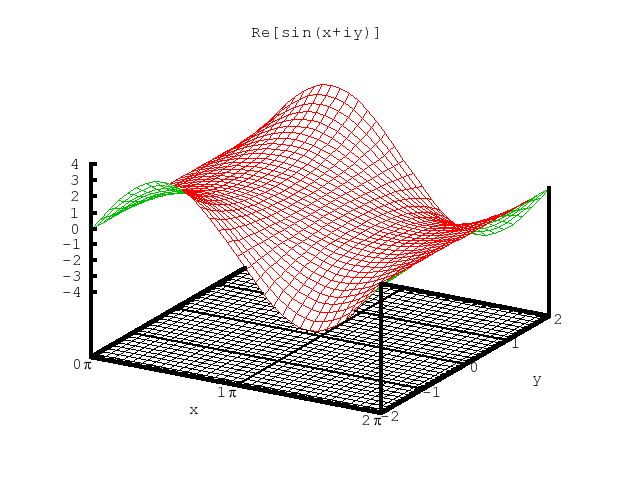 |
|
Figure 1. The real part of sinz, i.e., sinxcoshy
|
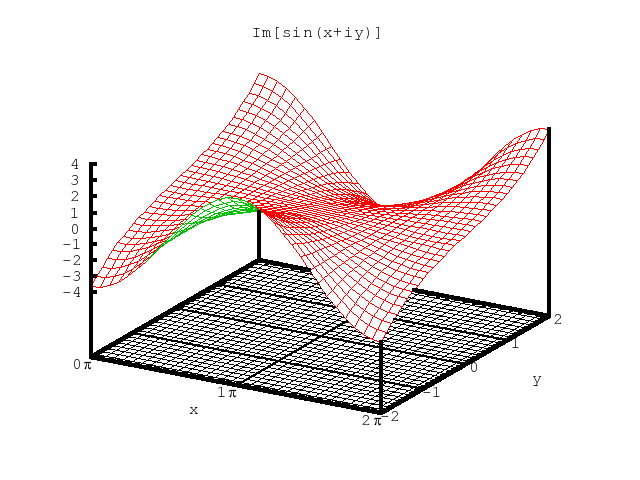 |
|
Figure 2. The imaginary part of sinz, i.e., cosxsinhy
|
In a similar fashion, the angle sum formula for cosine yields
 |
(12) |
which, again, still has period 2π.
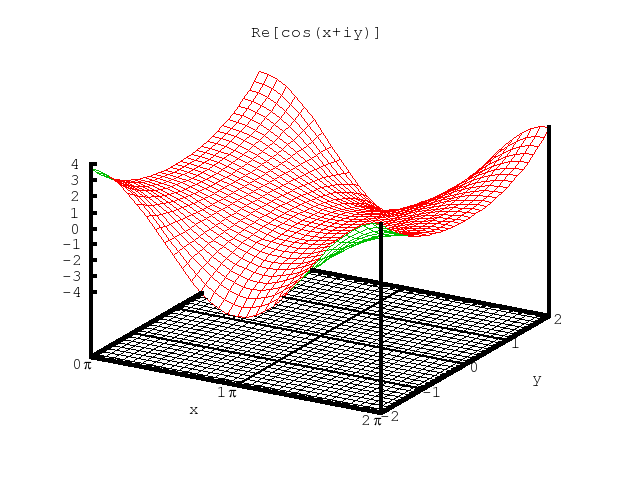 |
|
Figure 3. The real part of cosz, i.e., cosxcoshy
|
 |
|
Figure 4. The imaginary part of cosz, i.e., -sinxsinhy
|
The case of the tangent function is much more complicated, and the
details of derivation are omitted here. Suffice it to say that
the angle sum formula for tangent, along with other identities
involving the trigonometric and hyperbolic functions
(which identities are omitted herein), yield, after a fair amount
of algebra
 |
(13) |
Note that the period here is π, and that the graphs shown below
depict effectively one period, i.e.,
‑0.45π < x < 0.45π.
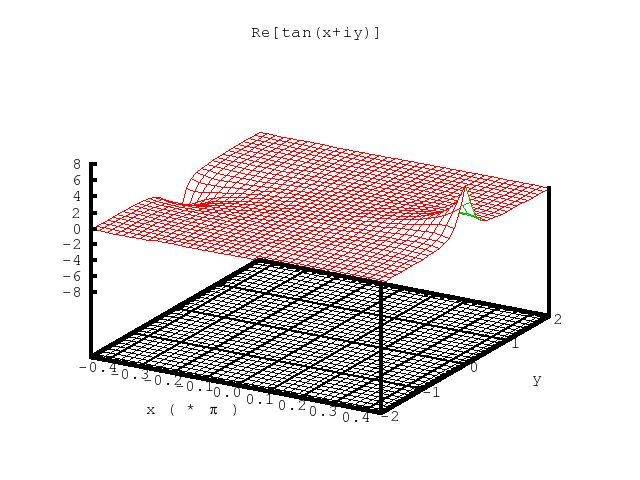 |
|
Figure 5. The real part of tanz
|
 |
|
Figure 6. The imaginary part of tanz
|
The Complex Valued Natural Logarithm
The formulae for the inverse trigonometric functions of complex
argument depend on the complex valued natural logarithm, which
function is described here.
First, write the complex number z in both rectangular and
polar form:
 |
(14) |
where
 |
(15) |
and
 |
(16) |
Note that, in eqn. (16), the inverse tangent function returns
a value of φ such that
‑π < φ ≤ π, depending
upon the quadrant in which z resides. Next, taking the natural
logarithm of eqn. (14) then yields the desired function:
 |
(17) |
The Complex Valued Inverse Trigonometric Functions
In order to find the formula for the inverse sine function, rewrite
eqn. (3) as
 |
(18) |
which we want to invert, i.e.,
 |
(19) |
Thus, multiply eqn. (18) by e ix to obtain
the quadratic in e ix
 |
(20) |
whose solution for x is
 |
(21) |
Interchanging x and y in eqns. (19) and (21)
then gives the desired formula
 |
(22) |
where the plus branch of eqn. (21) was used in order for
eqn. (22) to give the principal branch of the inverse sine
function.
The derivations of formulae for inverse cosine and
inverse tangent follow exactly the same procedure as just outlined
above for inverse sine. One obtains
 |
(23) |
and
 |
(24) |
both of which correspond to the principal branch.
Since x may be complex in eqns. (22) through (24),
these three equations define the (generally complex valued) inverse
trigonometric functions of complex argument.
TI-84 Programs
The TI-84 calculator evaluates both natural logarithms and square
roots of complex numbers. Thus, eqns. (22) through (24)
may be used to evaluate the inverse trigonometric functions of
complex argument with the TI-84. Simple TI-84 programs which do this
are listed directly below:
You will need the TI-Connect program on your computer to transfer
these programs from your computer to your calculator.
Examples
Example #1: Solve
 |
(25) |
for all values of θ.
SOLUTION:
Factoring eqn. (25) gives
 |
(26) |
so that
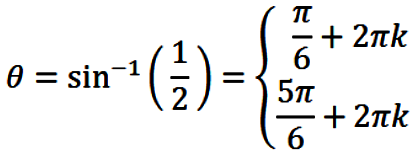 |
(27) |
and
 |
(28) |
where k can be any integer. In eqn. (27), the first
solution is obtained from the principal branch, and the
second solution is obtained from symmetry (for instance, via the
unit circle). Similarly, in eqn. (28), the first
solution is obtained from the principal branch, and the
second solution is obtained from symmetry (cf.,
Figures 1 and 2 above).
Example #2: Solve
 |
(29) |
for all values of θ.
SOLUTION:
Factoring eqn. (29) gives
 |
(30) |
so that
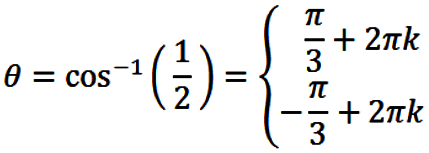 |
(31) |
and
 |
(32) |
where k can be any integer. In eqn. (31), the first
solution is obtained from the principal branch, and the
second solution is obtained from symmetry (for instance, via the
unit circle). Similarly, in eqn. (32), the first
solution is obtained from the principal branch, and the
second solution is obtained from symmetry (cf.,
Figures 3 and 4 above).
Example #3: Solve
 |
(33) |
for all values of θ.
SOLUTION:
Via the Quadratic Formula eqn. (33) gives
 |
(34) |
so that
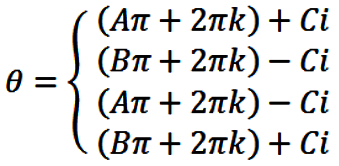 |
(35) |
where
 |
(36) |
 |
(37) |
and
 |
(38) |
Once again, in eqn. (35), k can be any integer.
Note that the first and third solutions in eqn. (35) are obtained from the
principal branches, and that the second and fourth solutions are obtained
from symmetry (cf., Figures 1 and 2 above).
|




















